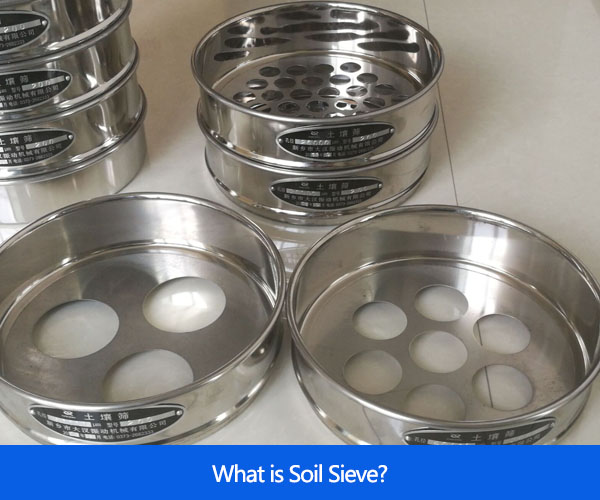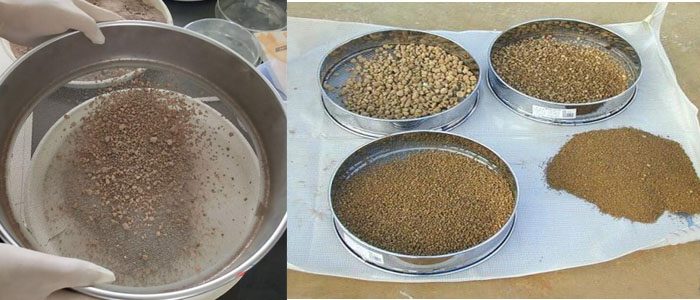Wednesday March-01 2023 09:13:27
Soil Sieve is the sieve that filters the soil. It is widely used in various laboratories for grading, screening, analysis and testing of samples. Equipped with a fully automatic laboratory vibrating screen, it is more efficient and safer. Soil sieves can be divided into square hole copper mesh, iron plate round holes and other types. Coarse sieves commonly used in geotechnical tests are generally round holes with apertures of 100, 80, 60, 40, 20, 10, 5, 2mm; fine sieves are generally It is a square hole, the equivalent hole diameter is 2.0, 1.0, 0.5, 0.25, 0.10, 0.075mm. There are some differences in the pore size classification of analytical sieves used in different countries and different departments;

Soil Sieve is mainly used in various laboratories, laboratories, item screening, sieving, grading and other inspection departments to accurately sieve, filter, Testing, soil analysis sieve has the advantages of low noise, soil sieve body, sieve, high efficiency of filtering samples, etc., and is widely used in scientific research and production, laboratories, quality and other departments of metallurgy, powder, chemical industry, medicine, building materials, geology, national defense and other departments. inspection room.

Soil Sieve is divided into: conventional standard sample sieve, chemical special sieve, soil special sieve, gravel special sieve, sand special sieve, cement special sieve, asphalt special sieve, coal sample special sieve, metallurgical ore inspection sieve, etc.

Soil Sieve is divided into three types, each with different characteristics and application ranges: wire woven mesh (the most widely used mesh is from 2.36 mm to 0.02 mm, only square hole mesh), punched plate screen (mainly used For large mesh, there are two kinds of round hole and square hole (mesh from 0.2 to hundreds of millimeters), electroforming screen (mainly used in high-precision occasions, and each mesh can be within the average error range) . Professional soil sieve manufacturers must have a tool microscope and a projector. The tool microscope is used to check the accuracy of the mesh, and the arithmetic mean method is used (the current method of Zxin is the normal distribution method).
1. Coarse sieves commonly used in soil sieve tests are generally round holes with apertures of 100, 80, 60, 40, 20, 10, 5, and 2mm; fine sieves are generally square holes with equivalent apertures of 2.0, 1.0, 0.5, 0.25, 0.10, 0.075mm. There are some differences in the grading of the analytical sieves used in different countries and departments;
2. Analytical balance, analytical balance requires two types according to the weighing range and accuracy: (1) weighing 10kg, sensing capacity 1g, (2) weighing 1000g, sensing capacity 0.1g;
3. Shaking machine, the specification stipulates that the shaking machine can shake in the horizontal direction and slap in the vertical direction. Shaking frequency is 100~200 times/minute, and tapping frequency is 50~70 times/minute;
1. From the air-dried loose soil samples, the soil was obtained by quartering.
2. Pass the sample through a 2mm sieve, and weigh the soil mass above and below the sieve, respectively. Take the soil on the 2mm sieve and pour it into the uppermost sieve of the coarse sieve that has been stacked in sequence, and pour the soil under the 2mm sieve into the Z upper sieve of the fine sieve that has been stacked in sequence (analytical sieves are stacked from top to bottom from large to small) put). Fully sieve and analyze with a shaker until the diameter of the soil particles on each sieve is larger than the sieve aperture, generally shake the sieve for 15-30 minutes;
3. Starting from the large-diameter sieve, remove each sieve in sequence, and weigh the soil left on each sieve to an accuracy of 0.1g. The difference between the sum of the soil mass on each sieve and the total soil mass shall not be greater than 1% of the total soil mass;
4. Calculate the particle group content and cumulative content, draw the gradation curve, obtain the characteristic particle sizes, analyze the gradation of the soil, and name it according to the specification φ200mm (11 pieces/set+bottom cover) 0.074, 0.25, 0.5, 1.0, 2.0, 5 , 10, 20, 40, 60mm soil sieve frame material: It is composed of stainless steel plate, brass plate, cold-rolled iron sheet (chrome or zinc), plastic and other materials. It adopts one-time stamping forming, the screen frame is flat, the finish is high, and the sieve assembly interchangeability is good.
Soil Sieve Structure and Specifications
Soil Sieve Structure ① Screen surface: It is composed of metal and non-metal materials such as brass, phosphor bronze, stainless steel wire mesh, iron plate with round holes, and ...
Soil Sieve Test Method and Introduction
Soil Sieve is used as a supporting test sieve and slapping sieve of 200mm50, and is widely used in various laboratories for classifying, sieving, analyzing and testing samples. Soil...
How much is a set of Standard Soil Sieve
Standard Soil Sieve Price: $20.00 - $200.00/Set Standard Soil Sieve is mainly used for soil screening and testing. A set of Standard Soil Sieve produced by Dahan Machinery includes ...
Mar 01, 2023
Soil Sieve Structure and Specifications
Soil Sieve Structure ① Screen surface: It is composed of metal and non-metal materials such as bras...
Mar 01, 2023
Soil Sieve Test Method and Introduction
Soil Sieve is used as a supporting test sieve and slapping sieve of 200mm50, and is widely used in va...
Mar 01, 2023
Soil Sieve is the sieve that filters the soil. It is widely used in various laboratories for grading,...
Feb 27, 2023
How much is a set of Standard Soil Sieve
Standard Soil Sieve Price: $20.00 - $200.00/Set Standard Soil Sieve is mainly used for soil screening...
![]()
Then we look forward to hearing from you
Contact Us
Industrials
Yanjin county forest park gate to the west 1000 meters north road sitemap
